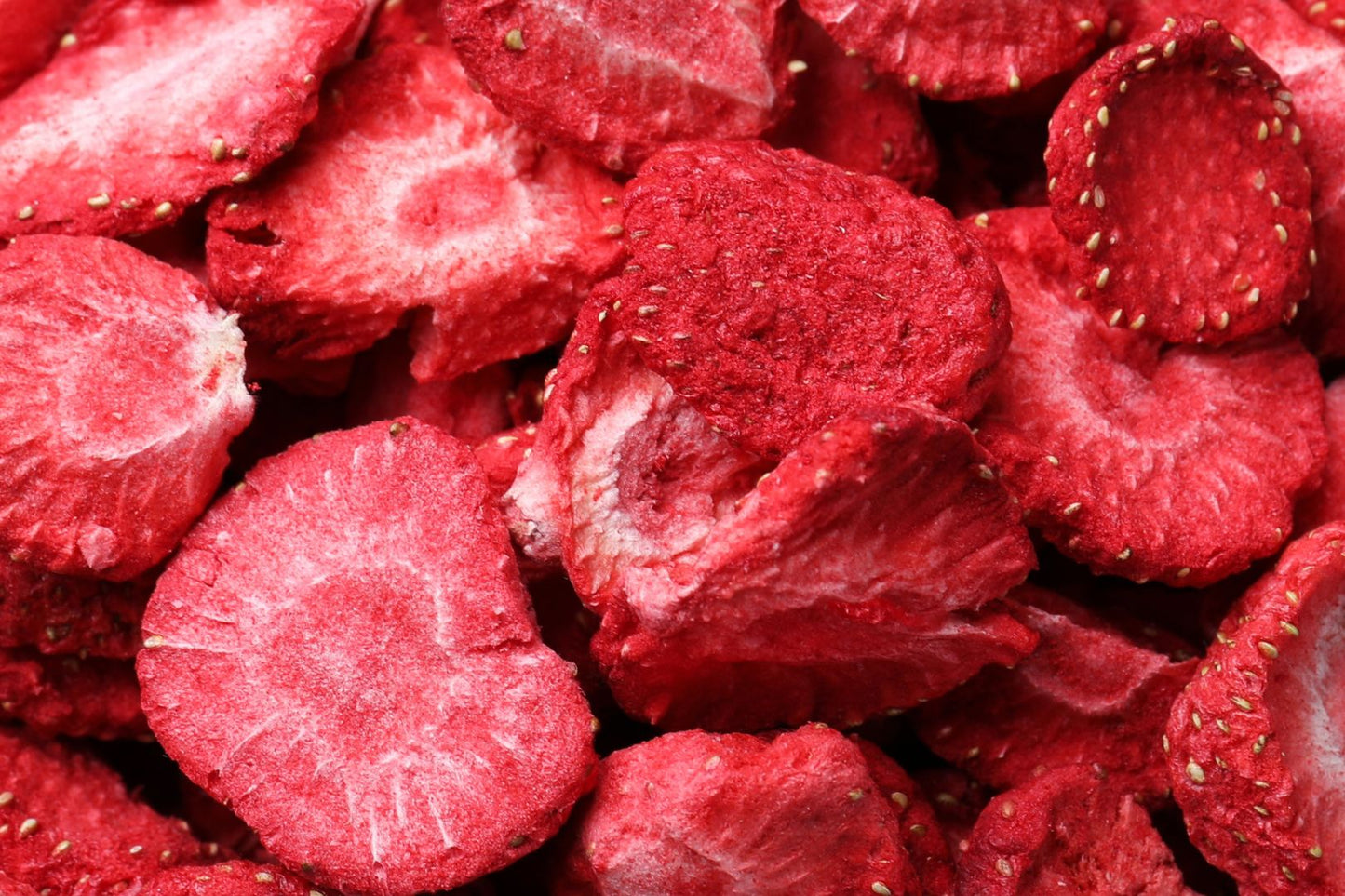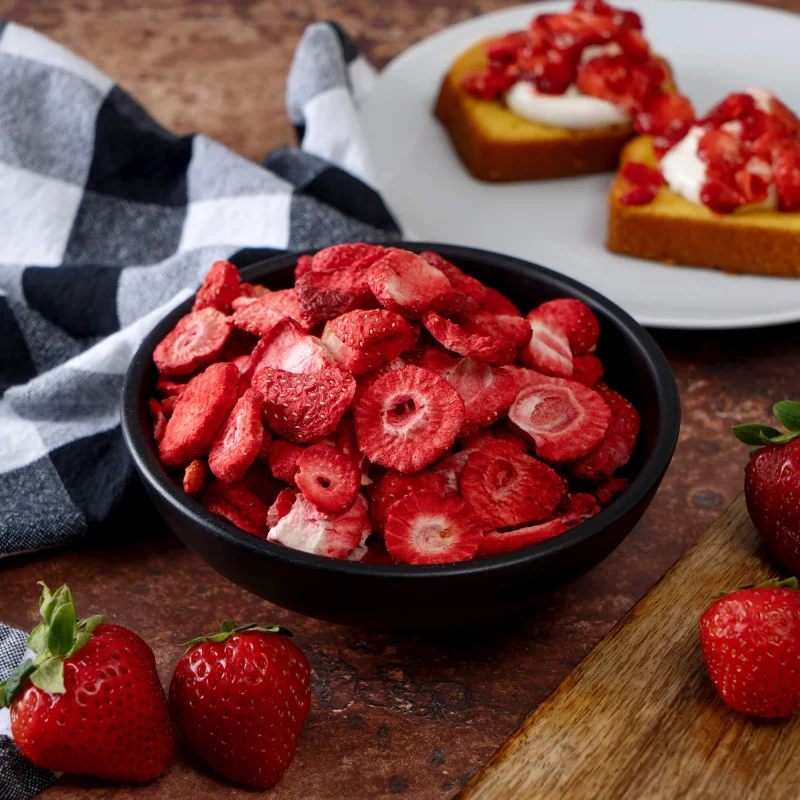Dried strawberries are a delicious and convenient snack enjoyed worldwide. But have you ever wondered how these sweet and chewy treats make their way from fresh fruit to the dried form you find in stores? The transformation process is fascinating, combining careful cultivation, advanced technology, and traditional methods. In this article, we’ll take a behind-the-scenes look at the journey of strawberries from fresh to dried.
Step 1: Selecting the Perfect Strawberries

The journey begins at strawberry farms, where fresh strawberries are grown under optimal conditions. These berries thrive in regions with well-drained soil and plenty of sunlight. Farmers select specific strawberry varieties known for their sweetness, flavor, and ability to retain their quality during drying.
Harvesting is a critical step. Ripe strawberries are handpicked to ensure they are at peak flavor and nutritional value. Only the best berries, free from bruises and imperfections, are chosen for drying.
Step 2: Cleaning and Sorting
After harvesting, strawberries are transported to processing facilities. The first step here is thorough cleaning. The berries are washed multiple times to remove dirt, pesticides, and any other contaminants.
Once cleaned, the strawberries are sorted based on size, ripeness, and quality. Uniform size ensures even drying, while optimal ripeness guarantees the best flavor in the final product.
Step 3: Preparation for Drying
Before the drying process begins, strawberries must be prepared. This typically involves:
- Hulling: Removing the green leafy tops of the strawberries.
- Slicing: Cutting the berries into even slices for faster and more uniform drying. Some processors leave them whole for certain products like candied dried strawberries.
In some cases, strawberries are pre-treated with natural substances like lemon juice or ascorbic acid to preserve their color and prevent oxidation during drying.
Step 4: The Drying Process

Drying is the heart of the transformation process. Several methods are used to remove moisture from the strawberries while retaining their flavor, texture, and nutritional content:
1. Air Drying
Air drying involves exposing the strawberry slices to warm, dry air in a controlled environment. This method is commonly used for large-scale production. The process can take several hours and results in chewy, sweet dried strawberries.
2. Freeze-Drying
Freeze-drying is a high-tech process where strawberries are frozen and placed in a vacuum chamber. The water in the berries sublimates (turns from ice to vapor), leaving behind a lightweight, crisp product. Freeze-dried strawberries retain more nutrients and a crunchier texture compared to air-dried ones.
3. Sun Drying
In some traditional practices, strawberries are dried under the sun. This method is eco-friendly and adds a slightly different flavor, though it’s less common in commercial production due to time and weather constraints.
4. Dehydration
Dehydrators use consistent heat and airflow to remove moisture. This is a popular method for smaller batches or home-dried strawberries.
Step 5: Post-Drying Treatments
Once dried, strawberries undergo additional processing to enhance their shelf life and flavor. These steps may include:
- Conditioning: Ensuring the moisture level is evenly distributed throughout the batch to prevent spoilage.
- Optional Additions: Some dried strawberries are coated with sugar or natural syrup to enhance sweetness. Others remain unsweetened for health-conscious consumers.
Step 6: Packaging and Storage
Dried strawberries are then packaged in airtight containers, resealable bags, or vacuum-sealed packs. Proper packaging protects them from moisture, light, and air, ensuring they stay fresh and flavorful until they reach consumers.
Labels provide important information, including ingredients, nutritional facts, and storage instructions. The strawberries are then stored in climate-controlled facilities before distribution.
Step 7: Distribution and Enjoyment
Packaged dried strawberries are distributed to retailers, online stores, and food manufacturers around the world. From there, they find their way into your pantry, ready to be enjoyed as a snack or added to your favorite recipes.
The Nutritional Benefits of Dried Strawberries
Throughout this journey, dried strawberries retain much of their nutritional value. They are rich in:
- Antioxidants: Protect against cell damage and promote overall health.
- Dietary Fiber: Supports digestion and keeps you feeling full longer.
- Potassium and Vitamins: Essential for heart health and immunity.
While the drying process concentrates sugars and calories, dried strawberries remain a healthy, energy-boosting snack when consumed in moderation.
Conclusion
The journey of strawberries from fresh to dried is a meticulous process that combines traditional farming techniques with modern drying technology. From the fields to your snack bowl, every step is designed to preserve the berries’ natural flavor and nutritional benefits.
Whether you’re enjoying them as a standalone treat, adding them to your breakfast, or using them in baking, dried strawberries are a testament to the art and science of food preservation. The next time you reach for a handful, you’ll have a deeper appreciation for the care and effort that went into making these delightful snacks!

